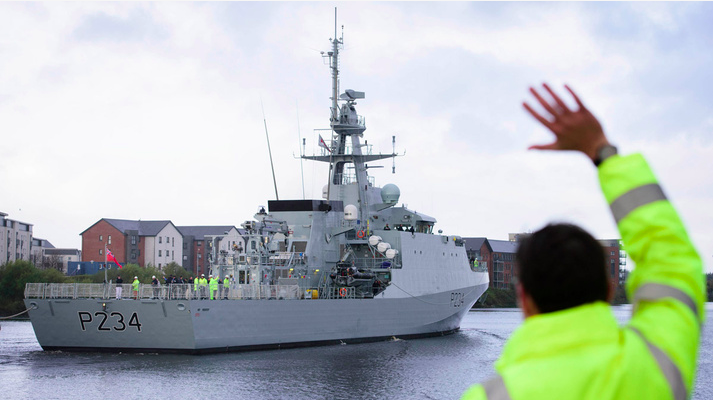
HMS Spey, the fifth and final River Class Batch 2 Offshore Patrol Vessel (OPV), departed BAE Systems’ shipyard in Glasgow earlier this week on her delivery voyage to her new home of Portsmouth Naval Base.
The departure of HMS Spey marks the completion of the Batch 2 OPV programme build phase, which has seen BAE Systems design, construct, commission and deliver five River Class OPVs to the Royal Navy in six years.
Having recently completed a programme of successful sea trials to fully test the vessel, HMS Spey will now join her four sister ships in the Royal Navy fleet. Thanks to a urea filter which reduces nitrogen oxide emissions from the diesel generators by about 90%, HMS Spey will be one of the most environmentally friendly ships to join the fleet.
At its peak, the programme sustained approximately 1400 jobs within BAE Systems and delivered a supply chain spend of almost £240m to more than 150 suppliers across the UK and Europe. The pace of the programme also provided a valuable opportunity for more than 200 BAE Systems apprentices to experience all aspects of ship design, construction, outfitting and test and commissioning.
Mike Macfarlane, OPV Delivery Director, BAE Systems Naval Ships, said: “We are immensely proud of our role in delivering these ships to the Royal Navy and this is a landmark moment for the River Class Batch 2 OPV programme, which showcases the skills and expertise we have here on the Clyde.
“Working collaboratively with the Royal Navy, the UK Ministry of Defence and our suppliers, we have successfully overcome this year’s COVID-19 challenges to deliver this strategically important programme which will benefit and protect our nation’s interests at home and abroad.
“As the final OPV to leave the Clyde, we will be sad to see HMS Spey go, but wish her, her Commanding Officer and crew all the best in their new home with the Royal Navy in Portsmouth.”
Mark Beverstock, Head of the OPV and Type 26 Delivery Teams at DE&S, said: “As well as delivering five ships to the Royal Navy, the OPV programme has played a crucial role in ensuring shipbuilding capability for the future while focusing on continuous improvement.
“The standard of presentation of the Batch 2 OPVs improved continuously through the programme. HMS Spey achieved ‘best in class’ and I am very proud of the team, who have fought adversity and have all raised their game in order to complete the programme on time and on budget.”
The OPV programme has provided a significant opportunity to continue to invest in new cutting-edge technologies and processes to deliver greater capabilities to the Royal Navy. It has also supported the development of new talent that will now go on to contribute to the successful delivery of the next generation City Class Type 26 ships, which are also being designed and built by BAE Systems on the Clyde.
Through these programmes, the Company is able to maintain critical engineering skills that are vital to sustaining the UK’s world-leading industrial base, as well as supporting the continual development of its employees’ capabilities in the design, construction, and integration of complex warships.
Upon arriving into Portsmouth, HMS Spey will be officially handed over to the Royal Navy. Once commissioned, she will enter a period of ship’s staff workup and her first maintenance period under the Contractor Logistics Support programme (CLS) which will be delivered by BAE Systems’ Maritime Services business, which delivers upkeep and maintenance for the entire Royal Navy surface fleet based at Portsmouth.
image courtesy of BAE Systems
If you would like to join our community and read more articles like this then please click here
BAE Systems City Class Type 26 HMS Spey Offshore Patrol Vessel







